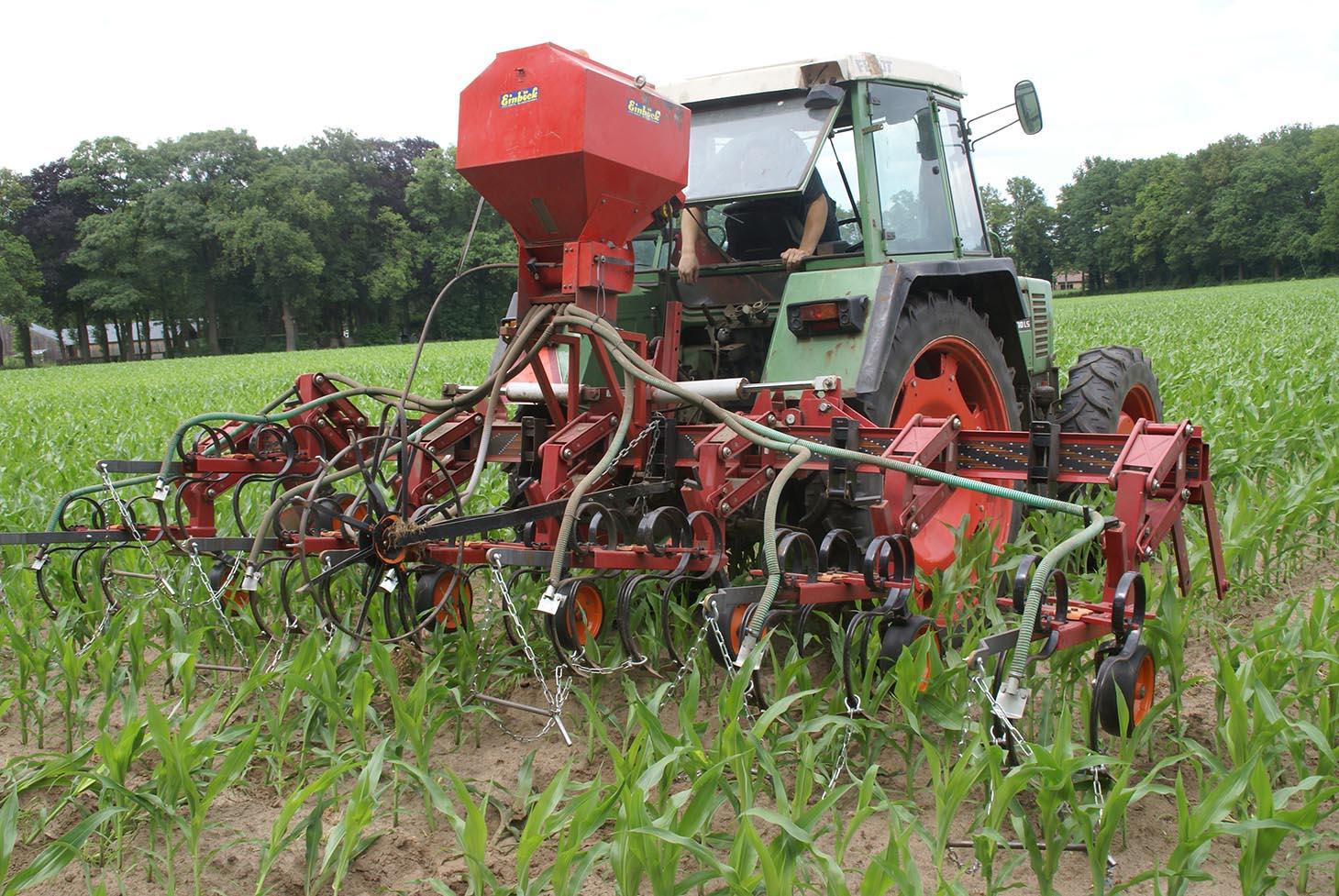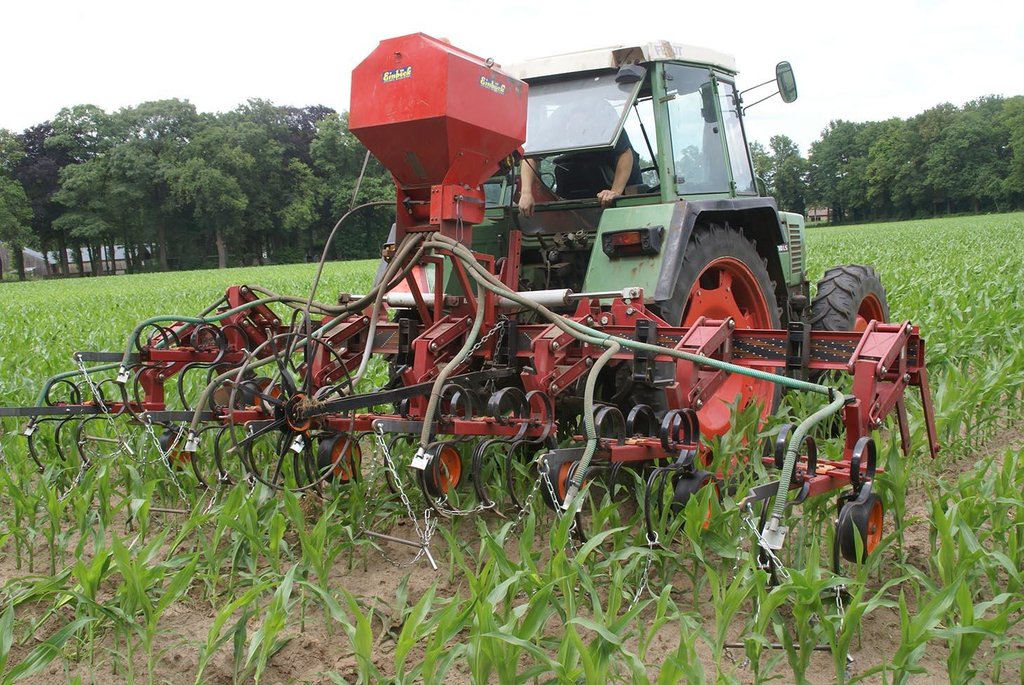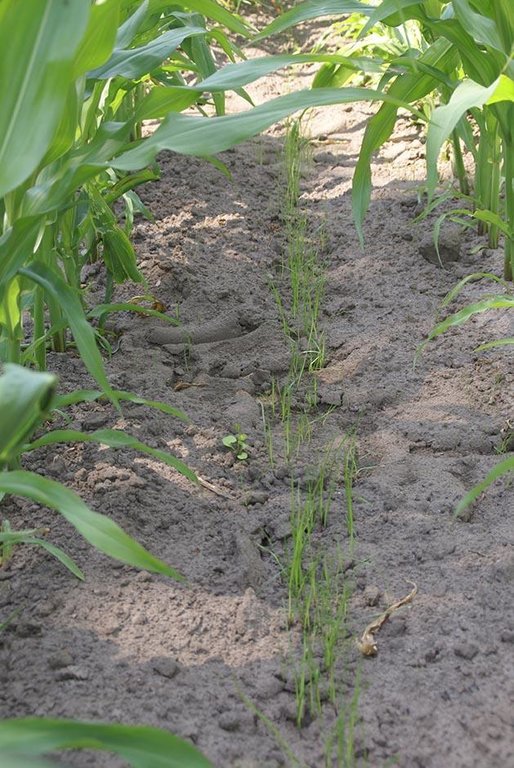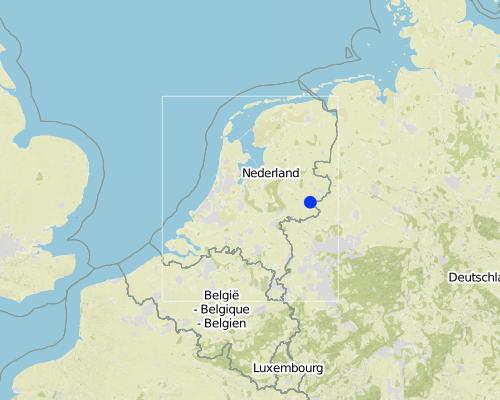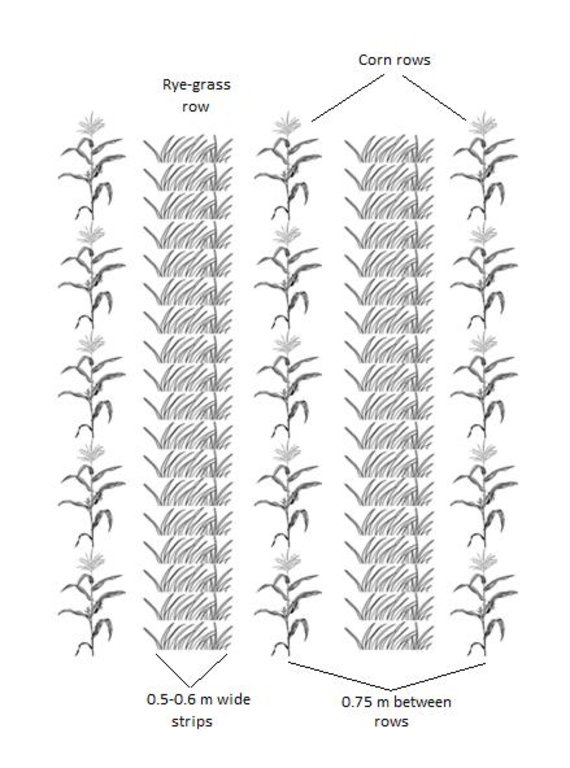Intercropping of grass and corn to increase soil organic matter [Netherlands]
- Creation:
- Update:
- Compiler: Jason Stuka
- Editor: –
- Reviewer: Fabian Ottiger
Gras onderzaai bij mais (NL)
technologies_1248 - Netherlands
View sections
Expand all Collapse all1. General information
1.2 Contact details of resource persons and institutions involved in the assessment and documentation of the Technology
SLM specialist:
Smit Annemieke
Wageningen Environmental Research (Alterra)
Droevendaalsesteeg 4, 6708 PB Wageningen
Netherlands
SLM specialist:
Leever Henk
HOEDuurzaam
Netherlands
SLM specialist:
Rienks Willem
Rom3D
Dorshorst 1a 7217 PH Harfsen
Netherlands
Name of project which facilitated the documentation/ evaluation of the Technology (if relevant)
Preventing and Remediating degradation of soils in Europe through Land Care (EU-RECARE )Name of the institution(s) which facilitated the documentation/ evaluation of the Technology (if relevant)
Provincie Gelderland - NetherlandsName of the institution(s) which facilitated the documentation/ evaluation of the Technology (if relevant)
Hoe Duurzaam - NetherlandsName of the institution(s) which facilitated the documentation/ evaluation of the Technology (if relevant)
Ministerie van Economische Zaken - NetherlandsName of the institution(s) which facilitated the documentation/ evaluation of the Technology (if relevant)
Vitens - Laat Water Voor Je Werken - NetherlandsName of the institution(s) which facilitated the documentation/ evaluation of the Technology (if relevant)
Wageningen Environmental Research (Alterra) - Netherlands1.3 Conditions regarding the use of data documented through WOCAT
When were the data compiled (in the field)?
20/03/2015
The compiler and key resource person(s) accept the conditions regarding the use of data documented through WOCAT:
Yes
1.5 Reference to Questionnaire(s) on SLM Approaches
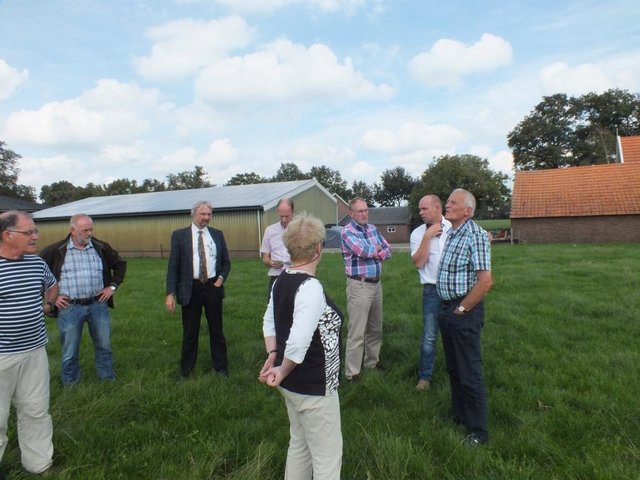
Regional process, social innovation [Netherlands]
Social innovation for sustained soil organic matter, clean drinking water and sustainable crop production
- Compiler: Simone Verzandvoort
2. Description of the SLM Technology
2.1 Short description of the Technology
Definition of the Technology:
Grass intercropping on corn fields
2.2 Detailed description of the Technology
Description:
Italian rye grass is sown when the corn has grown to knee height, and has not yet developed a closed cover. The grass is plowed into the soil several months after the harvest of the corn crop.
Purpose of the Technology: The purpose of the technology is to enable a good growth of the catch crop (the grass) and to increase root biomass production after the corn is harvested. This will contribute to the organic mater content of the soil, and reduce the leaching of nitrogen and potassium. After underplowing of the grass, the nitrogen and potassium will be released to the soil and become available for the next crop.
Establishment / maintenance activities and inputs: When corn is well established (between 30-60 cm height), grass is seeded between rows. A special seeder is required. Tractor must have tires that fit between corn rows. Grass germinates, but growth is reduced as corn matures and creates shade. When corn is harvested, grass continues to grow as a winter catch-crop. Some years, grass is sprayed with fertiliser to increase mineralisation. Grass is cultivated into the soil in early spring.
Natural / human environment: Multi-functional rural area with land use for agriculture, recreation, residence and nature. Dairy agriculture in small farms for Dutch standards combined with arable cropping. High livestock density.
Undulating landscape with cover sands and clayey and loamy sediments. Podzols and cambisols developed in sandy substrate. The area also has patches of anthroposols, soils enriched in Medieval times with manure and organic residues. Phosphate and nitrogen levels in these soils are in general high.
Mean monthly temperature varies between 2 and 17°C. The long-term mean annual precipitation is between 800 and 825 mm, with the lowest amounts in spring, and the highest in autumn. The long-term average annual precipitation deficit is between 200 and 240 mm.
2.3 Photos of the Technology
2.5 Country/ region/ locations where the Technology has been applied and which are covered by this assessment
Country:
Netherlands
Region/ State/ Province:
Gelderland
Further specification of location:
Haarlo - Oude Eibergen
Comments:
Boundary points of the Technology area: Left: 52.098865, 6.563182
Right: 52.095031, 6.634282
Top: 52.111764, 6.589390
Bottom: 52.081761, 6.620607
Map
×2.6 Date of implementation
If precise year is not known, indicate approximate date:
- less than 10 years ago (recently)
2.7 Introduction of the Technology
Specify how the Technology was introduced:
- through land users' innovation
Comments (type of project, etc.):
The land users's initiative was through the application for the project Healthy Sand by a group of farmers. During the Gezond Zand Project the group organised themselves in the Foundation HOEDuurzaam. The project ran from 2012-2014 and is followed by the new project BodemRijk.
The external initiative was from the drinking water company Vitens and the Province of Gelderland in the same period.
3. Classification of the SLM Technology
3.2 Current land use type(s) where the Technology is applied

Cropland
- Annual cropping
Main crops (cash and food crops):
Major cash crop: potatoes
Major food crop: Maize, cereals
Other: Grass
Comments:
Major land use problems (compiler’s opinion): The main soil threat in the Olden-Eibergen Case Study area is the gradual decline of soil organic matter stocks. On average, agricultural fields have lost up till 5.4% of organic matter in the last 10 years according to farmers. This threatens the agricultural potential of the soil as well as its water holding capacity, and its potential to buffer leaching of nutrients and pesticides. In the long term, agricultural productivity will fall, costs of agricultural inputs such as manure, fertilizers, pesticides and irrigation will increase and the additional costs for cleaning drinking water withdrawn from ground water will rise.
Major land use problems (land users’ perception): The group of farmers in the area experience declining crop production, problems with too dry and too wet soils, and decreasing organic matter content in soil due to long-term monocultures of maize, the use of pig manure and legislation forcing farmers to process or export manure from their farms.
Grazingland comments: Nothing filled in in this section, since the technology applies specifically to maize cropping.
Type of grazing system comments: Nothing filled in in this section, since the technology applies specifically to maize cropping.
3.3 Further information about land use
Comments:
Water supply: rainfed, mixed rainfed - irrigated
Number of growing seasons per year:
- 1
Specify:
Longest growing period in days: 250Longest growing period from month to month: March - November
3.4 SLM group to which the Technology belongs
- Intercropping
3.5 Spread of the Technology
Comments:
Total area covered by the SLM Technology is 0.94 m2.
94 ha over 32 fields. 20 farmers applied this technology.
3.6 SLM measures comprising the Technology

agronomic measures
- A1: Vegetation/ soil cover
- A2: Organic matter/ soil fertility

vegetative measures
- V1: Tree and shrub cover
Comments:
Main measures: agronomic measures
Type of agronomic measures: cover cropping, green manure, rotations / fallows
Type of vegetative measures: aligned: -linear
3.7 Main types of land degradation addressed by the Technology
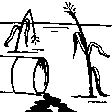
chemical soil deterioration
- Cn: fertility decline and reduced organic matter content (not caused by erosion)
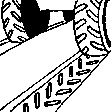
physical soil deterioration
- Pc: compaction
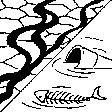
water degradation
- Hq: decline of groundwater quality
Comments:
Main type of degradation addressed: Cn: fertility decline and reduced organic matter content
Secondary types of degradation addressed: Pc: compaction, Hq: decline of groundwater quality
Main causes of degradation: soil management (ploughing for renewal of grassland or rotation to arable cropping), governance / institutional (Stricter manure legislation since January 2014 deriving from the EU Nitrates Directive has forced farmers to process part of the manure from their farms on-farm, or to export it from their farms.)
Secondary causes of degradation: crop management (annual, perennial, tree/shrub) (long-term monoculture of maize and intensive cropping of seed potatoes)
3.8 Prevention, reduction, or restoration of land degradation
Specify the goal of the Technology with regard to land degradation:
- prevent land degradation
- reduce land degradation
Comments:
Main goals: mitigation / reduction of land degradation
Secondary goals: prevention of land degradation
4. Technical specifications, implementation activities, inputs, and costs
4.1 Technical drawing of the Technology
4.2 Technical specifications/ explanations of technical drawing
After the corn crop is growing, a tractor with a seeder sows Italian Rye-grass seeds between the rows of corn. The grass seeds are sown in strips parallel to the corn rows. The corn rows are 0.75 metres apart. The grass strips are usually between 0.50 and 0.60 metres wide, but this is according to the farmer's preference. this means that a spacing of between 0.075 and 0.125 metres remains bare on each side of the grass strip, between the grass and the corn.
Location: Haarlo - Oude Eibergen. Gelderland
Date: April 8 2015
Technical knowledge required for field staff / advisors: moderate
Technical knowledge required for land users: moderate
Technical knowledge required for agricultural contractor: high (technical skills are required from an agricultural contractor with a special machine to sow the grass in the already standing maize crop.)
Main technical functions: increase in organic matter, increase of biomass (quantity)
Secondary technical functions: improvement of ground cover, improvement of topsoil structure (compaction), increase in nutrient availability (supply, recycling,…), increase / maintain water stored in soil, improvement of water quality, buffering / filtering water
Cover cropping
Material/ species: Italian rye-grass
Quantity/ density: 25 kg/ha
Remarks: Between corn rows width 0.075-0.125 m bare space.
Green manure
Material/ species: Italian rye-grass
Quantity/ density: 25 kg/ha
Remarks: Between corn rows width 0.075-0.125 m bare space.
Rotations / fallows
Remarks: The Italian rye grass is worked into the soil ca 5 months after the harvest of the maize.
Aligned: -linear
Vertical interval between rows / strips / blocks (m): not applicable
Width within rows / strips / blocks (m): 0.75-1.25
Grass species: Italian rye grass
Slope (which determines the spacing indicated above): not applic%
4.3 General information regarding the calculation of inputs and costs
other/ national currency (specify):
Euro
Indicate exchange rate from USD to local currency (if relevant): 1 USD =:
0.94
Indicate average wage cost of hired labour per day:
255.70
4.4 Establishment activities
| Activity | Type of measure | Timing | |
|---|---|---|---|
| 1. | Buy a seeder | Agronomic |
4.5 Costs and inputs needed for establishment
| Specify input | Unit | Quantity | Costs per Unit | Total costs per input | % of costs borne by land users | |
|---|---|---|---|---|---|---|
| Equipment | Seeder | Machine | 1.0 | 5327.05 | 5327.05 | |
| Total costs for establishment of the Technology | 5327.05 | |||||
Comments:
Duration of establishment phase: 0 month(s)
Life span of the seeder: 6 years
4.6 Maintenance/ recurrent activities
| Activity | Type of measure | Timing/ frequency | |
|---|---|---|---|
| 1. | Seeding | Agronomic | After corn is established |
| 2. | Fertilizer | Agronomic | Every other year |
4.7 Costs and inputs needed for maintenance/ recurrent activities (per year)
| Specify input | Unit | Quantity | Costs per Unit | Total costs per input | % of costs borne by land users | |
|---|---|---|---|---|---|---|
| Equipment | Machine use | ha | 1.0 | 117.2 | 117.2 | 100.0 |
| Plant material | Seeds | ha | 1.0 | 42.62 | 42.62 | 100.0 |
| Fertilizers and biocides | Fertilizer Hired(machine+fert) | ha | 1.0 | 9.06 | 9.06 | 100.0 |
| Total costs for maintenance of the Technology | 168.88 | |||||
Comments:
Machinery/ tools: Specific tractor to perform grass undersowing (seeder), tractor, sprayer/applicator
To seed the Rye-grass strips between the corn rows. Done a few months after the corn is seeded.
4.8 Most important factors affecting the costs
Describe the most determinate factors affecting the costs:
New equipment (Seeder) - The seeding and fertilizer applications are hired from a company. The company purchases the new equipment to seed between the corn rows.
The greatest determinate factor to the land users are then the cost of hired machine hours.
5. Natural and human environment
5.1 Climate
Annual rainfall
- < 250 mm
- 251-500 mm
- 501-750 mm
- 751-1,000 mm
- 1,001-1,500 mm
- 1,501-2,000 mm
- 2,001-3,000 mm
- 3,001-4,000 mm
- > 4,000 mm
Specifications/ comments on rainfall:
182 days of precipitation annually
Agro-climatic zone
- sub-humid
Thermal climate class: temperate. Mean monthly temperatures vary between 2-17 °C (LGP 240-269 days, mean monthly temperatures vary between 2-17 °C)
5.2 Topography
Slopes on average:
- flat (0-2%)
- gentle (3-5%)
- moderate (6-10%)
- rolling (11-15%)
- hilly (16-30%)
- steep (31-60%)
- very steep (>60%)
Landforms:
- plateau/plains
- ridges
- mountain slopes
- hill slopes
- footslopes
- valley floors
Altitudinal zone:
- 0-100 m a.s.l.
- 101-500 m a.s.l.
- 501-1,000 m a.s.l.
- 1,001-1,500 m a.s.l.
- 1,501-2,000 m a.s.l.
- 2,001-2,500 m a.s.l.
- 2,501-3,000 m a.s.l.
- 3,001-4,000 m a.s.l.
- > 4,000 m a.s.l.
Comments and further specifications on topography:
Altitudinal zone: 0-100 m a.s.l. (up to 45 metres a.s.l.)
Slopes on average: Flat and gentle (Only incidental)
5.3 Soils
Soil depth on average:
- very shallow (0-20 cm)
- shallow (21-50 cm)
- moderately deep (51-80 cm)
- deep (81-120 cm)
- very deep (> 120 cm)
Soil texture (topsoil):
- coarse/ light (sandy)
- medium (loamy, silty)
Topsoil organic matter:
- high (>3%)
- medium (1-3%)
If available, attach full soil description or specify the available information, e.g. soil type, soil PH/ acidity, Cation Exchange Capacity, nitrogen, salinity etc.
Soil depth on average: Deep (A and B horizons up till 40 cm in Gleyic Podzols and Umbric Gleysols (ca 75% of the area) Hardly any soil organic matter below 15 cm. Rooting depth is up to 80 cm) and very deep (Deep topsoils rich in organic matter in the Fimic Anthrosols (12% of the area))
Soil texture is coarse/light (Most soils have a sandy texture due to the substrate consisting of cover sands) and medium (Soils in former creek valleys contain loam (Umbric Gleysols))
Soil fertility is low (most soils have a low fertility due to the sandy substrate (specifically the Gleyic Podzols, ca 40% of the area)) or very high (in Fimic Anthrosols originated due to application of farmyard manure since medieval times (12% of the area))
Topsoil organic matter is medium-high (The purpose of the pilot project is to increase soil organic matter)
Soil drainage/infiltration is good (deep ground water table (H > 40-80 cm; L>120 cm) in the sandy soils on thick substrate of cover sands (in 65% of the area)) and medium (shallow groundwater tables in the Umbric Gleysols (35% of the area))
Soil water storage capacity is very high (in the Fimic Anthrosols with high SOM in the topsoil) and medium (in the other soils, varying with the soil organic matter content)
5.4 Water availability and quality
Ground water table:
< 5 m
Availability of surface water:
medium
Water quality (untreated):
poor drinking water (treatment required)
Comments and further specifications on water quality and quantity:
Ground water table is <5m (in all soil types the highest level of the groundwater table during the year is <140 cm below the soil surface. The lowest level can be lower than 120 cm)
Availability of surface water is medium (from small rivers (De Berkel) and creeks)
Water quality (untreated) is poor drinking water (treatement required - levels of the pesticides Bentazon, and MCPP in the groundwater have incidentally exceeded the norms for drinking water production between 1985 and 2009.)
5.5 Biodiversity
Species diversity:
- medium
Comments and further specifications on biodiversity:
Soil biodiversity is high in the Fimic Anthrosols.
5.6 Characteristics of land users applying the Technology
Market orientation of production system:
- mixed (subsistence/ commercial
Off-farm income:
- less than 10% of all income
Relative level of wealth:
- average
Individuals or groups:
- individual/ household
Level of mechanization:
- mechanized/ motorized
Gender:
- men
Indicate other relevant characteristics of the land users:
Land users applying the Technology are mainly common / average land users
Difference in the involvement of women and men: Most outdoor farm operations are completed by men.
Population density: 10-50 persons/km2
Annual population growth: negative
100% of the land users are average wealthy and own 100% of the land.
Off-farm income specification: Some farmers are contractual workers. Wives of farmers often have a job, e.g. at the municipality, craft work. No B&B activities or educational services.
Market orientation: Mixed (Maize is completely used to feed cows (max 20% of the area is allowed under maize); other arable crops are sold to the market. Dairy production is commercial.)
5.7 Average area of land owned or leased by land users applying the Technology
- < 0.5 ha
- 0.5-1 ha
- 1-2 ha
- 2-5 ha
- 5-15 ha
- 15-50 ha
- 50-100 ha
- 100-500 ha
- 500-1,000 ha
- 1,000-10,000 ha
- > 10,000 ha
Is this considered small-, medium- or large-scale (referring to local context)?
- medium-scale
Comments:
15-50 ha 6 land owners (source: geoinformation from the project gezpnd Zand)
50-100 15 land owners (source: geoinformation from the project gezpnd Zand)
5.8 Land ownership, land use rights, and water use rights
Land ownership:
- individual, titled
Land use rights:
- leased
- individual
Comments:
All agriculture land is owned or rented by individual farmers. Some farmers lease their land to other farmers. Leased land is less well managed, resulting in lower organic matter contents. Investments in SLM would lead to a higher renting fee, or the land owner taking the land back in exploitation.
5.9 Access to services and infrastructure
health:
- poor
- moderate
- good
education:
- poor
- moderate
- good
technical assistance:
- poor
- moderate
- good
employment (e.g. off-farm):
- poor
- moderate
- good
markets:
- poor
- moderate
- good
energy:
- poor
- moderate
- good
roads and transport:
- poor
- moderate
- good
drinking water and sanitation:
- poor
- moderate
- good
financial services:
- poor
- moderate
- good
6. Impacts and concluding statements
6.1 On-site impacts the Technology has shown
Socio-economic impacts
Production
crop production
Comments/ specify:
Expected increase of maize production: to 6-7 tonnes/ha. Not proven yet.
Possible competition between crop and grass. Not shown yet.
risk of production failure
Comments/ specify:
Expected. Not proven yet.
Water availability and quality
demand for irrigation water
Comments/ specify:
Only for farmers with fields at higher elevations and drier soils.
Income and costs
workload
Comments/ specify:
Saves seeding winter crop in autumn.
Added planning, but work is hired.
Undersowing of grass in the standing maize crops requires specific skills.
Socio-cultural impacts
community institutions
Comments/ specify:
Created farmer's foundation.
SLM/ land degradation knowledge
Comments/ specify:
Farmers understanding ecological impacts of farming practices and organic matter in soils.
conflict mitigation
Comments/ specify:
Farmers collaborating with water company.
Improved livelihoods and human well-being
Comments/ specify:
Dairy farmers have learned more about the importance of soil organic matter for their production systems, and about the consequences of soil management on soil organic matter and other aspects of soil health. This learning was brought by the exchange of knowledge between farmers and experts, and between farmers themselves. Farmers also profited from services provided to them by the farmers' foundations: shared investments (e.g. in the manure separator) and support in the application for subsidies to finance the SLM measure.
Ecological impacts
Water cycle/ runoff
water quantity
Comments/ specify:
Insignificantly more water transpiration.
water quality
Comments/ specify:
Expected. Not proven yet.
surface runoff
Comments/ specify:
Expected. Not proven yet. Little to no slope.
excess water drainage
Comments/ specify:
Expected. Not proven yet.
groundwater table/ aquifer
Comments/ specify:
Insignificantly more water transpiration.
Soil
soil moisture
Comments/ specify:
Expected. Not proven yet. Claimed by some farmers already.
soil cover
Comments/ specify:
Not measured but observed on photographs.
soil compaction
nutrient cycling/ recharge
Comments/ specify:
Expected. Not proven yet.
soil organic matter/ below ground C
Comments/ specify:
Expected. Not proven yet.
Biodiversity: vegetation, animals
biomass/ above ground C
Comments/ specify:
Not measured but observed on photographs.
plant diversity
beneficial species
habitat diversity
Comments/ specify:
Expected. Not proven yet.
pest/ disease control
Comments/ specify:
Possibly. Not proven.
Climate and disaster risk reduction
emission of carbon and greenhouse gases
Comments/ specify:
Expected. Not proven yet.
6.2 Off-site impacts the Technology has shown
downstream flooding
Comments/ specify:
Expected. Not proven yet.
groundwater/ river pollution
Comments/ specify:
Expected. Not proven yet.
buffering/ filtering capacity
Comments/ specify:
Expected. Not proven yet.
6.3 Exposure and sensitivity of the Technology to gradual climate change and climate-related extremes/ disasters (as perceived by land users)
Gradual climate change
Gradual climate change
| Season | Type of climatic change/ extreme | How does the Technology cope with it? | |
|---|---|---|---|
| annual temperature | increase | well |
Climate-related extremes (disasters)
Meteorological disasters
| How does the Technology cope with it? | |
|---|---|
| local rainstorm | well |
Climatological disasters
| How does the Technology cope with it? | |
|---|---|
| drought | well |
Other climate-related consequences
Other climate-related consequences
| How does the Technology cope with it? | |
|---|---|
| reduced growing period | well |
Comments:
No modifications to the technology in response to climate change.
6.4 Cost-benefit analysis
How do the benefits compare with the establishment costs (from land users’ perspective)?
Short-term returns:
neutral/ balanced
Long-term returns:
slightly positive
How do the benefits compare with the maintenance/ recurrent costs (from land users' perspective)?
Short-term returns:
negative
Long-term returns:
neutral/ balanced
Comments:
Farmers are subsidized for seeding rye-grass between corn rows. If not subsidized, they are unlikely to invest. Few farmers have seen short-term benefits. Their willingness to invest is based on their understanding of the long-term benefits, brought about by the Approach developed in the Project Gezond Zand (and in RECARE).
6.5 Adoption of the Technology
If available, quantify (no. of households and/ or area covered):
20
Of all those who have adopted the Technology, how many have did so spontaneously, i.e. without receiving any material incentives/ payments?
- 0-10%
Comments:
100% of land user families have adopted the Technology with external material support
20 land user families have adopted the Technology with external material support
6.7 Strengths/ advantages/ opportunities of the Technology
| Strengths/ advantages/ opportunities in the land user’s view |
|---|
|
increases soil organic matter How can they be sustained / enhanced? annual application of the measure; subsidy to execute the measure |
|
increases maize crop yield in the long term How can they be sustained / enhanced? annual application of the measure |
| reduces leaching of nitrogen, potassium and pesticides to the groundwater |
| Strengths/ advantages/ opportunities in the compiler’s or other key resource person’s view |
|---|
|
increases soil organic matter How can they be sustained / enhanced? annual application of the measure; subsidy to execute the measure |
| increases available soil moisture |
| reduces leaching of nitrogen, potassium and pesticides to the groundwater |
6.8 Weaknesses/ disadvantages/ risks of the Technology and ways of overcoming them
| Weaknesses/ disadvantages/ risks in the land user’s view | How can they be overcome? |
|---|---|
| Uncertainty of the success or positive effect of the measure. | |
| Uncertainty of negative effects to the crop. | |
| Uncertainty of competition between grass and crop for nutrients and moisture. | |
| Concerns about cost and labour | |
| Uncertainty of hindrance from legislation. |
| Weaknesses/ disadvantages/ risks in the compiler’s or other key resource person’s view | How can they be overcome? |
|---|---|
| technology requires hiring of skilled labour and machinery, which is not viable without subsidy in the short term | provide subsidy in the first 3-5 years of implementation |
7. References and links
7.2 References to available publications
Title, author, year, ISBN:
RECARE_WP3 Report: CS_11_Ouden-Eibergen_v2Annemieke Smit and Simone Verzandvoort2014
Available from where? Costs?
Freeannemieke.smit@wur.nl
7.3 Links to relevant information which is available online
Title/ description:
Gezond Zand: Met een verbeterde bodemkwaliteit naar een betere waterkwaliteit Haarloseveld en Olden EibergenBy Willem Rienks and Henk Leever2014
URL:
Freehttp://www.hoeduurzaam.nl/images/gallery/nieuws/Brochure/BrochureHoeduurzaam%20Definitief.pdf
Title/ description:
Unravelling changes in soil fertility of agricultural land in The NetherlandsArjan Reijneveld2013
URL:
Wageningen University Library http://library.wur.nl/WebQuery/wda/2044057
Links and modules
Expand all Collapse allLinks

Regional process, social innovation [Netherlands]
Social innovation for sustained soil organic matter, clean drinking water and sustainable crop production
- Compiler: Simone Verzandvoort
Modules
No modules


